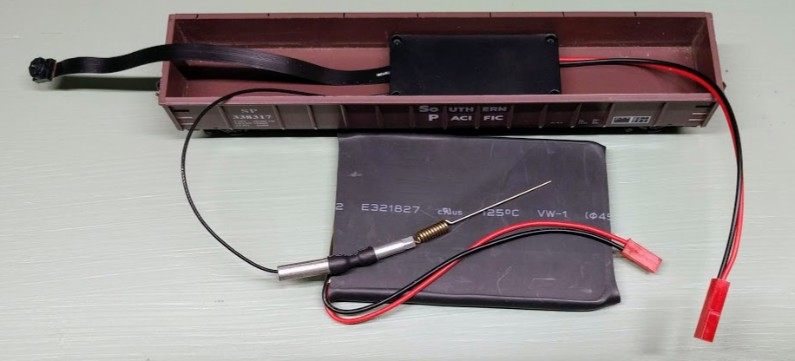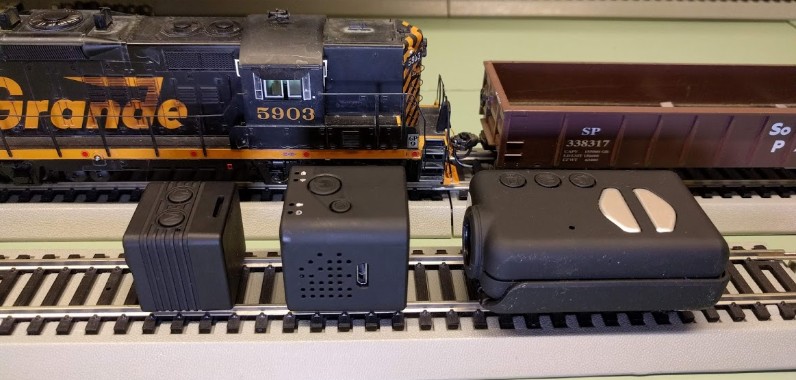Model Train-related Notes Blog -- these are personal notes and musings on the subject of model train control, automation, electronics, or whatever I find interesting. I also have more posts in a blog dedicated to the maintenance of the Randall Museum Model Railroad.
2019-06-15 - Cotton Belt 9389
Category TrainJim gave me this engine, with the sole purpose of changing the horn. How hard can it be?
Click here to continue reading...
Jim got this engine for Randall in commemoration of the 150th Anniversary of the Transcontinental Railroad.
My first attempts at doing that video were miserable as the engine would stop constantly at slow speed and I tried a few things to see if I could improve the power pickup.
Click here to continue reading...
One of the main concepts to be added in Conductor 2 is the concept of routes.
Conductor 1 already has “route” definitions. These are actually intended for display on the remote tablets. A route is defined using:
- A name,
- A DCC throttle object, used to display the engine speed and direction;
- The JMRI sensor used for the automation toggle on/off.
- A counter of number of times the automation started (incremented by the script).
The counter thing was a quick attempt at gathering some stats initially and never used -- it’s technically displayed by RTAC on the tablet, but the UI layout was designed for 2 routes, and with the current 3 routes the counter is ironically not visible. Even when it was visible, nobody was looking at it. Thus I suggest dropping it eventually, which will remove a couple lines from the script.
The concept of routes in Conductor 2 is supposed to be more elaborate. However I’d posit it can just be an extension of what is in Conductor 1 at the syntax level in the script.
So what properties would I want in a Conductor 2 route?
Click here to continue reading...
Routes, Profiles, or even the latter idea of Includes for Conductor 2 are all vaguely unsatisfactory.
Includes are just a hack in the current v1 script language which do not really solve anything.
The core issue is modularization of the script.
One concept I explored earlier in the 2018-12-08 post and that I still want are routes.
A route is a sequence of blocks and a reservation principle. They have different modes, e.g. global interlocking vs ABS window interlocking. I think this concept is good and should be kept as-is.
Click here to continue reading...
2019-03-08 - Conductor 2: Evaluating Languages
Category Rtac
Conductor 1 uses a custom language implemented using ANTLR 4. The goal for Conductor 2 is to reuse an existing scripting engine.
Continuing with this, recently I started looking more closely at Lua to see if it could be a potential configuration language.
Click here to continue reading...
2019-01-26 - Conductor 2: Routes & Profiles
Category Rtac
I have been thinking about my definitions of routes & profiles for Conductor 2 and I am not convinced they will be useful as such for Randall.
I am interested in two kind of routes:
- “Linear simple” routes: typical circuit loop with ABS-type block guards. There are mostly linear and simple means they don’t have complex rules. There still could be customizations: different speeds for different blocks, specific customizations such as grade crossing horns, etc. Some of these may depend on an engine number (especially sound F functions).
- “Dedicated Shuttle” routes: this is mostly what we have at Randall right now where routes are a mix of generic block mapping conditions and carefully dedicated to specific engines.
Click here to continue reading...
2019-01-20 - Mini Wifi Camera and Train Layout Usage
Category Video
I’m continuing my exploration of what we can do using these cheap small mini cameras when it comes to train layouts, and today’s subject is this mini pinhole wifi camera. How well does it work and what can we use it for?
Mini pinhole camera compared to an HO-sized gondola
Click here to continue reading...
2018-12-14 - Conductor 2: Route / Events Programming
Category Rtac
Just to keep some perspective, here is how the current Conductor 1 script is architectured:
- There are 3 routes, 2 for passenger and 1 for branchline, with the passenger ones alternating.
- Where appropriate, the routes define variables for speed & timers upfront so that they can be adjusted for new engines / train configuration.
- They lack profiles but these are essentially an extension of the current setup.
- Within each route are sequences. Since the script is a parallel execution script, the sequences are implemented using state keeping, but that’s mostly what the states are for.
- That’s actually a bit of an issue as it makes the states hard to figure and keep track of, creating some unforeseen complications sometimes.
- There are events not associated with any route.
- Main example is the Sonora switch in non-automated mode.
- A lesser example is the RTAC display especially for stopped/error modes.
Having changed the trains for automation recently, I can see where the system works and where it breaks:
- Mostly I changed the passenger trains just by adjusting the speeds.
- I did alter 1 or 2 timers, for example the Freight’s run time before stopping at the mid station.
- It broke when I tried to use an MTH engine as its functions usage is vastly different.
- Same goes for the Rapido which has more fancy functions. In that case changing the engine in a route would require customizing the script for different functions.
Click here to continue reading...
2018-12-09 - SQ23 Mini Camera for Cab Rides
Category Video
After trying the SQ12 camera, I moved on to its newer sibling, the SQ23. The goal is to use it to record cab rides. As this one has wifi, a secondary goal is to see if it’s suitable as a “live camera” e.g. to broadcast a ride view to a screen.
Cab ride filmed using SQ23 Camera
This is the SQ23 Camera I got from Amazon (can be found cheaper elsewhere, e.g. on Aliexpress), compared to my Mobius Action Cam and the SQ12 camera:
From left to right: SQ12, SQ23, Mobius compared to an HO-size engine + gondola
Click here to continue reading...
2018-12-08 - Conductor 2: Route Sequences
Category Rtac
Above I mentioned the key features for Conductor 2 would be profiles, configuration language, and routes.
I should elaborate a bit on this, especially the routes.
First the profiles: A profile is simply a DCC address number and a map of variables values. Routes will define variables for, e.g., timers and speeds. The profile will fill in these values to adjust them to a specific train.
Click here to continue reading...


